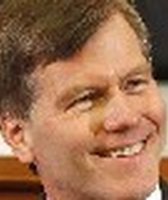Stand up for the facts!
Our only agenda is to publish the truth so you can be an informed participant in democracy.
We need your help.
I would like to contribute
Tim Kaine says the economy has added private sector jobs 12 months in a row
Amid cheers of "Run, Tim, run," former Gov. Tim Kaine was the star attraction at the Virginia Democratic Party’s annual Jefferson-Jackson Dinner Feb. 19.
With fellow Democrat Jim Webb’s announcement that he will not seek a second term in the U.S. Senate next year, Kaine is under intense pressure to run for the seat. He tossed the hungry crowd slabs of red meat by criticizing the Republican Party’s economic record.
Kaine, now chairman of the Democratic National Committee, said the economy has performed better under President Barack Obama than it had under his predecessor, George W. Bush.
"Two years into a Democratic administration gross domestic product is not shrinking; it is growing again," he said. "We’ve now gained private sector jobs 12 months in a row."
With the U.S. unemployment rate at 9 percent and millions still out of work from the recession, we wondered if this jobs claim is true.
Private sector jobs cover workers not employed by the federal government, a state, city or county. Of the roughly 130 million Americans who currently hold jobs counted by BLS, about 83 percent of them, or 107.8 million, worked in the private sector last month.
There are two sources for job data. One is the federal Bureau of Labor Statistics, which releases information on job creation and the unemployment rate each month. The second source is Automatic Data Processing, a business outsourcing company that conducts a wide-ranging, monthly employment survey of private businesses.
According to BLS, private payrolls climbed by 144,000 people during March 2010 and have risen every month since then, meaning they have increased for 11 straight months. In January, the most recent month for which data are available, private payrolls added 50,000 jobs, according to preliminary estimates.
It’s worth noting that total payrolls, which include government jobs as well as private ones, have been on a roller coaster during the past year. Total payrolls posted big gains in March, April and May of 2010, helped by the hiring of short-term Census Bureau workers. But as those short-term jobs ended during the summer and fall, total payrolls slumped, falling each month from June through September. State and local budget cuts also meant fewer government jobs.
Since October, total payrolls have been on the climb.
What about the data from ADP, which focuses solely on private-sector jobs? Data show slow job growth began in March 2010 and continued until September, when 2,000 private jobs were lost. Growth resumed in October and has lasted four straight months.
In 2009, the private sector lost about 5 million jobs, and during the first quarter, the economy was shedding more than 700,000 jobs every month. Now it is gaining 700,000 jobs over the course of six to eight months. That suggests we face a long road to full recovery.
William Johnson, a labor economist at the University of Virginia, said this recession and the dot-com recession in 2000 were different from past slumps. In previous downturns, he said, output declined more than payrolls ebbed. Companies, in effect, kept more employees than were strictly necessary because they wanted to retain their skills for better times ahead.
That paradigm shifted in 2000 and 2008, Johnson said. Companies cut employees faster than they reduced production, asking the remaining staff to work harder and pick up the slack.
"It’s a new pattern, and nobody has really been able to explain it," Johnson said. "Some people say it is the health care law introducing uncertainty about the cost of hiring new employees, but it also happened in 2000 when there was no health care bill."
Top officials at the Federal Reserve have projected that the national unemployment rate will remain at or slightly below 9 percent for the rest of 2011 and stay above 7 percent into 2013. The national unemployment rate was roughly 5 percent before the recession began in 2008.
Let’s review. The official government source on employment says private sector job growth has occurred in each of the last 11 months. ADP, another nationally respected source on job growth, says private payrolls grew in 10 of the last 11 months and fell by just 2,000 jobs in the one month where a decline was reported.
Speaking as an advocate of the president and his party’s policies, Kaine presented private sector job growth in the best possible light. But it is important to remember that the economy has recovered just 20 percent of the private sector jobs lost in 2009.
Kaine said private sector jobs have been created for "12 months in a row." He was close, but missed the bull’s eye. We rate his statement Mostly True.
Our Sources
Tim Kaine, Speech at Jefferson-Jackson Dinner, Feb. 19, 2011.
Bureau of Labor Statistics, Labor market figures 2008-2011, accessed Feb. 21, 2011.
ADP, February 2010, National Employment report, accessed Feb. 21, 2011.
ADP, March 2010, National Employment report, accessed Feb. 21, 2011.
ADP, September 2010, National Employment report, accessed Feb. 21, 2011.
ADP, October 2010, National Employment report, accessed Feb. 21, 2011.
ADP, January 2011, National Employment report, accessed Feb. 21, 2011.
Federal Reserve, Minutes of the FOMC, Jan. 25-26, 2011 meeting, accessed Feb. 22, 2011.
Richmond Times-Dispatch, Crowd at Democratic gala urges Kaine to run for Senate, accessed Feb. 21, 2011.
E-mail interview with Alec Gerlach, Democratic National Committee spokesman, Feb. 21, 2011.
Interview with William Johnson, Professor of economics, University of Virginia, Feb. 23, 2011.
Browse the Truth-O-Meter
More by Jacob Geiger
Tim Kaine says the economy has added private sector jobs 12 months in a row
Support independent fact-checking.
Become a member!
In a world of wild talk and fake news, help us stand up for the facts.























































